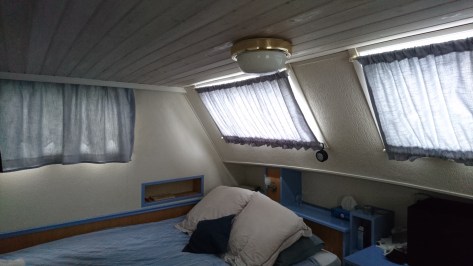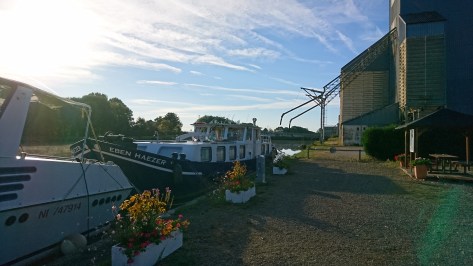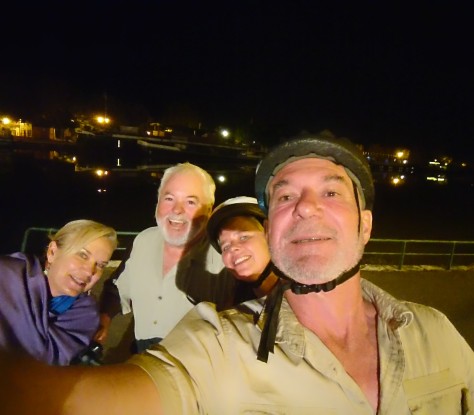Leaving Digoin and crossing the Loire via the elevated pont-canal, we started our journey westwards down the Loire along the lateral canal that tracks the river as far as Briare. Our first stop was at Coulanges, a village without much but at least the halte had services and was very peaceful. We had both happy and sad encounters here…. we came across a wreath laid by the canal in memory of someone who had died – possibly, we thought, a drowning, given the location of the sad memorial. Our spirits were lifted soon afterwards by the sweet sounds of a lady singing French folk songs as she picked wild fruit from a tree by the canal.
We continued through a couple more pleasant days on the canal, witnessing the sacred, the profane and the quotidien. The sacred came in the form of a glimpse of the extensive complex of the Abbaye Notre Dame des Sept-Fons – a Cistercian monastery founded in 1132 that later joined to the Trappist order; it now houses around 90 monks, many of them novices from around the world. All we got to see as we passed by on the canal, in truth, was a wall and a gate – but from what we know it is a remarkable complex. The profane came very close by, in the form of a massive canalside foundry on the opposite bank. The quotidien, to our delight, was the éclusier at the last lock of the day before arriving in Beaulon, a wonderfully jovial fellow who unashamedly celebrated his love of the colour blue.
Beaulon proved to be a pleasant stopover – nice mooring with services, some interesting old homes, a chateau (privately owned, not accessible), plus the important thingsd in a small village… boulangerie, boucherie and epicerie with small café. We spent a couple of enjoyable days there, dreaming of re-opening the lovely ivy-clad restaurant that had closed down sometime earlier.
After Beaulon, we arrived in Gannay-sur-Loire, the new resting place for Eben Haezer for the three weeks we would be away visiting Jane’s family in Wales. We had originally hoped to reach the large port of Nevers for this, but a broken lock downstream forced us to choose here instead. To be honest, there was not much to Gannay; the free municipal mooring was limited to a maximum of 48 hours and the private canal-bank marina was somewhat over-priced for a place right off the beaten track with not much to offer in shopping, services or transport. Cést la vie, we made the best of it.
Although there was little in the way of shops, and we had to catch an expensive taxi to get to the rail station in Decize, Gannay was not completely devoid of charm and interest. The Romanesque church of Saint-Jean-Baptiste had unfortunately been extensively destroyed in the Revolution but had preserved its choir and stone vault and a carved statue of the Virgin. There was a very pleasant small café restaurant opposite the church, where we shared a meal with the New Zealand friends we had met in Digoin. There was an interesting relic of a linden tree in the main square by the church, originally planted in 1620 by Sully, Louis XIV’s grand voyer minister of state, part of a scheme to plant such trees in villages throughout France, to act as meeting points after Mass to discuss and manage the affairs of the parish, and to mark important road routes. This particular arbre de Sully had seen better days, having been damaged when the trailer of a lorry detached and smashed into it. The remains of its trunk have been preserved under its own little steeple. And we had a little friend visit us daily at our mooring – a coypu, a South American aquatic rodent introduced to Europe and now fairly common along the canals and rivers. We often see them swimming but this was the first time one had so fearlessly approached so close to us.
To get to Wales, we had to catch a taxi to Decize, then a train to Nevers, where we had reserved a hire car for the trip. We then left Gannay in the car on 6 August and travelled to Calais via Orléans, Chartres and Rouen, then to St Asaf via Dover and a funny little rural BnB in Huntley in Herefordshire. That trip, over three delightful weeks, is a story for another place. I returned a week before Jane to do some work on Eben Haezer before picking her up at the airport in Lyon, where she had flown from Manchester.
I was able to do some good restorative work on the boat while at Gannay, including some repairs to sections of the wheelhouse that had suffered timber rot, and a good coat of paint in various areas crying out for it. I was also able to fit new curtains to our bedroom windows which Jane’s Mum had made up for us in Wales.
Finally, on 30 August we left Gannay to continue our cruise down the Canal Latéral à la Loire.
After a break for the éclusier’s lunch at Saulx, we made an overnight stop on the canal outside Decize, then the next day on to Fleury-sur-Loire, a small village with a simple mooring but with services (water and electricity) and a cheap and cheerful café in a couple of marquees overlooking the canal.
After a couple of enjoyable days we headed into Nevers, a large town/small city, the capital of the Nièvre department in Bourgogne-Franche-Comté. We had intended to leave our boat here for the three weeks we would be in Wales visiting Jane’s family, but a broken lock meant we had to change plans and we would now be here for only a couple of days. The port here is large and wide, but with many boats, and we found a comfortable place on the edge of the marina, giving us privacy and all services on a new long pontoon.
The city itself is quite charming, or at least the older part of it near the river. It had once been an important depot for Julius Caesar during his campaigns against the Gauls (though he suffered its sacking by the Aedui at one stage). From the 16th century it became a notable centre for the manufacture of faience (tin-glazed earthenware pottery). This heritage is reflected in two museums dedicated to faience, one of which was unfortunately closed when we were there, and another in the former Ducal Palace – the day we were there the Palace exhibits featured not only pottery and glazed works but a fascinating collection of cardboard sculptures of fantastic creatures. We also discovered the HQ of the Montagnon firm of faience manufacturers, which traces its origins to 1648 but which regrettably closed its doors permanently in 2015.
The narrow streets that lead away from the river are interesting, with many houses from the 14th to the 17th centuries. The Romanesque/Gothic Nevers cathedral (Cathédrale Saint-Cyr-Saint-Julitte) was imposing, as was the Romanesque Église Saint-Étienne, as well as the Ducal Palace and its adjacent Place de la République. We also enjoyed a ride through the Parc Roger Salengro to the Chapel of Saint Bernadette Soubirous, the witness to the apparitions of Our Lady of Lourdes in the 19th-century, who died in Nevers and whose “incorrupt body” remains on display. We chose not to view the corpse, but were delighted to find a large mosaic mural under construction in the adjacent courtyard.
Leaving Nevers we cruised to the little village of Cours-les-Barres, a pleasant stop but a place where it seems they have been somewhat opposed to beggars for a long time…
Our cruise from Cours-les-Barres included some lovely locks, well tended with flowers and attentive éclusiers – even when on the phone, as they always were.
Our next stop, la Chapelle-Montlinard proved to be a fascinating place. The mooring, by an industrial site, was less than salubrious, though adequate.

But the nearby town of La Charité-sur-Loire was something else altogether. Across the Loire from the canal mooring and up a slight rise, la Charité had some lovely surprises. The Église Notre-Dame de la Charité-sur-Loire is a magnificent ruin, largely preserved. With a history going back to the 8th century, and the current building dating from the 12th to 14th centuries, it is a marvel of ecclesiastical architecture, one of the foremost “daughters” of the famous Cluny Abbey. Its survival is even more remarkable, given it was marked for destruction in the Revolution and was turned into a series of trade enterprises – a pottery, a shoe manufacturer, a wine store – and then was earmarked for demolition in the 19th century to make way for the Paris-Nevers road (thankfully avoided). It has lost its western chapels and one of its towers, and its walls are green with mould, but it is superb.
For the last thirteen years, la Charité has been hosting an annual Festival du Mot, a literary festival, welcoming poets, writers, critics and the public to celebrate words (rather than just books), with each year dedicated to a particular word. The town has turned itself over to this, with numerous inscriptions and placards throughout town, on steps, walls, roadways and shopfronts.
Another highlight in la Charite was the les halles de loire, an unusual grocery/vegetable store by the river, established in an old abattoir that closed in 1984 and has been turned into a store specialising in local produce, fresh and preserved. It’s a interesting and atmospheric space (even the old rails and hooks for the carcasses have been maintained) and its products are genuinely good, local and sourced. There aren’t many spaces like this in France, and we were delighted to find it.
After la Charité we cruised to Ménétréol, the chief attraction of which was its proximity to the hilltop village of Sancerre, a lovely town and the centre of a noted wine region. It was a nice mooring, but as we approached a lady appeared on the quay, gesticulating and telling us we could not moor there because a large boat was due to arrive. We told her we had arrived and we were staying, and she disappeared. To our horror, we later discovered she was the proprietor of the dockside restaurant we had booked dinner at that evening! All the same, she was friendly and didn’t seem to mind, and the large boat didn’t arrive, so pas de problème. The restaurant was lovely… and clearly obsessed with hats!
The following day, however, the large boat did arrive. It was a hotel boat, and it was arrogant and aggressive. Our first inkling was when a young man pulled up to the port in a van and told us we had to move to make room. He did the same to the boat in front of us. That was when we first met John and Janet Hughes, from Sydney but now of the Gold Coast, fellow Australians who proved they don’t take shit. Tbe hotel boat arrived shortly afterwards and hovered beside us, the crew member yelling at us to move. John, a lawyer and immovable object, simply refused. He winked at me and continued his charade of non-cooperation for a while, insisting that the boat and its crew show a bit more respect and consideration. Eventually, however, we agreed to provide room for the hotel boat and its guests…. it meant we had to move as far back as possible and hammer in our ground stakes, but we were OK.
All that out of the way, we were free to ride our bikes up the hill to Sancerre, to take in the town and its views and its wine shops. It was a challenging ride up the hill but well worth it – the town is a delight, with a lovely square where we enjoyed lunch, great views and a series of narrow streets leading to our target… the Domaine Vacheron et Fils. We enjoyed a lovely tasting in their cave and ordered a couple of dozen bottles, which M. Vacheron undertook to deliver to us at the boat the following morning.
With the Sancerre wine delivered as promised and safely stowed, we set off for the tiny village of Léré, 18 kilometres further down the canal. We arrived at a peaceful setting with only one or two other boats. But lo and behold, events repeated themselves when a hotel boat arrived and rudely requested we shift our settled positions; once again, there had been no sign or warning of their arrival (some other hotel boats are considerate enough to leave notices at moorings to warn of their arrival, by date and ETA). This time it was the turn of the Englishman in front of us to play the role that our friend John had performed in Ménétréol, feigning offence and inconvenience and non-cooperation, until we eventually, reluctantly shifted our boats to make room. Such an unnecessary rigmarole! There was not much to the village, apart from an attractive small lavoir (communal wash house), a nice restaurant (which we did not visit on this occasion), a boulangerie, and the handsome 14th-century Église Saint-Martin.
Our next stop was at the attractive halte at Beaulieu, only a couple of hours further down the canal. On the way we could see in the distance the cooling towers of the Belleville nuclear power plant. Beaulieu is in a nice setting, with power and water, and the village is a delightful little place, with a boulangerie, a pleasant bar-tabac and the sweetest, smallest mairie we have seen. Unfortunately the boulangerie was closed for the annual summer holidays…. we were pretty sure what he would be up to – the photos and trophies in his window were not for achievement in bread-making but for catching fish!
From Beaulieu we headed towards Briare, our last stop on the Canal before turning north. Briare sits at the junction of the Loire River and its latéral canal, and the Canal du Briare. The Loire canal crosses the river just before the town along an elevated pont-canal, and we decided to stop just before it at a wild mooring, rightly suspecting that there might not be a suitable place for us in the town marinas. It was an easy cycle into town and it was peaceful and free! The pont-canal itself is a wonder – for a hundred years until 2003 it was the longest iron aqueduct in the world, at 662 metres, and it has a strong connection with Gustave Eiffel of Tower fame. It provides a great view of the river as you cross it.
Briare is an interesting an pleasant town, with an excellent marina (though with high demand and therefore limited space). The town has some excellent cafés and restaurants, some lovely walks along the riverside, a lot of waterways and waterside parks to walk through and a general air of ease and relaxation. One of our prime interests was the Musée de la Mosaique et des Emaux, dedicated to the mosaic and enamel industries that flourished here in the 19th and early 20th centuries. The Emaux de Briare company manufactured and exported millions of enamel buttons and beads, and pioneered the production of pre-cut mosaic tiles which were used to adorn buildings and to tile bathrooms and kitchens. Within the museum there is still today a factory which sells tiles, mosaic pieces, fixatives and glazes.
We were only in Briare for a short time, but we were fortunate to reconnect with our Australian friends John and Janet Hughes and to enjoy a lovely meal with them at the Restaurant Le Pont Canal, right by the aqueduct over the river. The meal was fantastic, made even better by John insisting on paying for us. Really lovely folk! The evening was perhaps a bit too enjoyable, judging by the selfie we took at the end of it.

So came the end of our cruise down the Canal Lateral a la Loire; our next stage would be a northward journey along the Canal de Briare and Canal du Loing back towards the Seine. Before we could get away, however, we had to navigate the pont-canal across the river…. a slow but relatively straightforward manoeuvre, but exhilirating in its own small way.




















































































